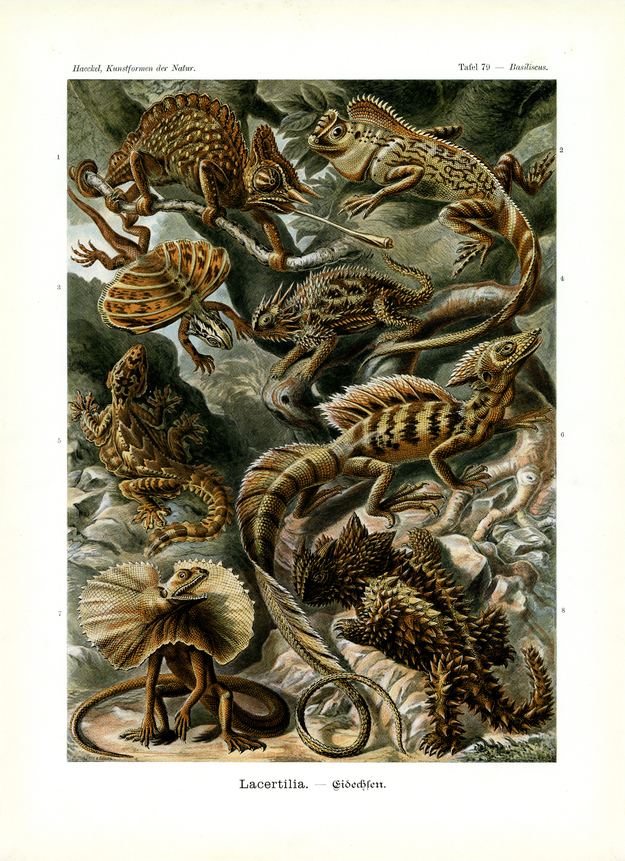Translation of the original German introduction by Ernst Haeckel:
Phylum of Vertebrata (Wirbeltiere); - main class of Gnathostoma (Kiefermäuler); - class of Reptilia (Schleicher); - subclass of Lepidosauria (Schuppenlurche); - order of Lactertilia (Eidechsen).
The varied order of lizards (Lacertilia) belongs to the oldest representatives of ‘Amnion-animals’ (Amniota), main division of the phylum of vertebrates comprising the three highest developed classes: reptiles, birds and mammals. Petrified lizards of the prehistoric era (Basilosaurus) can already be found in the sedimentary rock of the Triassic period and are closely connected to ‘stem-reptiles’ (Tocosauria) of the previous Permian period, from which they originate in a process of transmutation. Tocosaurians again originate from ‘shell-salamanders’ (Stegocephala) of the oldest ‘coal-period’, which are the oldest known quadrupedal and terrestrial vertebrates.
The usual body structure of the common lizard, the flat, triangular head, elongated body and tail, the low level of strength of the four short, five-toed legs closely resembles the shape of its older ancestor, ‘shell-salamanders’. A decisive difference when compared to the latter consists in the cornification of the epidermis, which came about with adaptation to the consistent inhabitation in dry air. The scalation of lizards, just like the one in snakes that descend from them, consists of a connected shell of ‘horn-scales’ (Pholides); this shell is slough off in repeated moulting and replaced by a new one. With a small portion only of today’s lizards the older shell of ‘bone-scales’ (Lepides) has been retained belonging to the layer of ‘leather-skin’ (Corium) right below. The ‘leather-skin’ is rich in colourful pigmentation deposited for the most part in diverse ‘pigment-grains’ in particular cells. These ‘pigment-cells’ (Chromatophora) are usually most flexible, and with their living plasma contracting in various ways, the well known colour change arises that is proverbial in chameleons, which, however, is equally seen in many other reptiles and amphibians (for example frogs). Frequently, with the help of sudden colour change, these animals adjust arbitrarily and in most striking ways to their surroundings. It has to be considered here that ‘pigment-cells’ are usually connected to most delicate ‘end-fibers’ of the nervous system; intense psychic emotions: shock, anger, dread etc. may cause a change of colour. A remarkable capacity of adaptation to the living conditions of many lizards is furthermore expressed in numerous other constitutions evoking significant variations of the usual body shape. The chameleon (fig. 1) for example is distinguished by long ‘climbing-legs’ and a long, worm-shaped tongue. In ‘aculeate lizards’ (fig. 4 and 8) the common horn scales have transformed into strong quills. In iguanas the dorsum is usually decorated with a long, pronged comb (fig. 2, 4 and 6). The ‘collar-lizard’ (fig. 7) possesses a broad collar that can be deliberately spread and put down. The ‘flying dragons’ (fig. 3 and 5) form a parachute with the help of a broad lateral lappet, similar to ‘flying squirrels’, using it to jump from tree to tree. The natural colour of lizards is most vivid and multi-shaded, highly changeable; the species presented here appear much more diverse and colourful compared to the illustration (for the sake of simplicity).
Translation by VR Translators Bangalore
We've scanned the original lithography at 1200dpi on the Epson A3 scanner of A3 scanner huren. You can download a 400dpi JPEG here.
